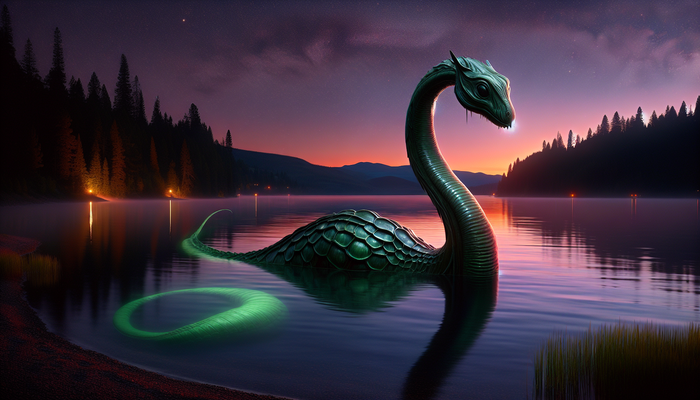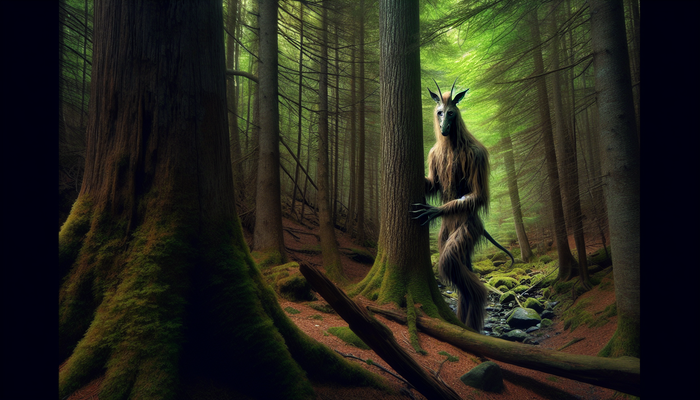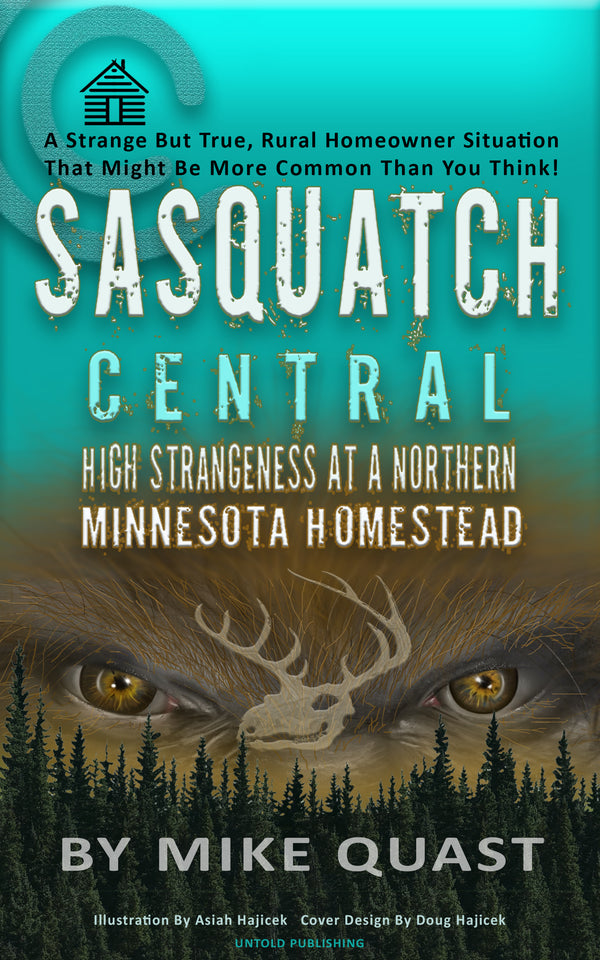Maine's Bigfoot Sightings

By Anthony Romano, Cryptozoologist
In the realm of cryptozoology, few creatures have captured the human imagination quite like Bigfoot. This elusive, ape-like being, also known as Sasquatch, has been the subject of countless stories, investigations, and debates. While most people associate Bigfoot sightings with the Pacific Northwest, the truth is that these enigmatic creatures have been reported in nearly every state across the country. One such place that has a surprisingly rich history of Bigfoot encounters is the state of Maine.
As a software engineer and Bigfoot enthusiast, I've always been fascinated by the idea that such a creature could exist in our modern world, undetected by science yet witnessed by so many. When I first began delving into the world of Bigfoot research, I was surprised to discover just how many sightings had been reported in Maine over the years. The more I investigated, the more I realized that Maine's vast wilderness and deep forests provide the perfect habitat for a creature like Bigfoot to thrive.
In this article, I'll be taking a deep dive into the mysteries of Maine's Bigfoot sightings. We'll explore the rich history of Bigfoot encounters in the state, from Native American legends to modern-day eyewitness accounts. We'll examine the unique characteristics of Maine's wilderness that make it an ideal location for Bigfoot, and we'll look at the work of dedicated researchers who have spent years investigating this phenomenon. By the end of this journey, I hope to shed new light on one of the most enduring mysteries of our time and perhaps even convince some skeptics that there may be more to the Bigfoot legend than meets the eye.
The Deep Roots of Bigfoot Lore in Maine
To understand the Bigfoot phenomenon in Maine, we must first look to the past. Long before the term "Bigfoot" entered the popular lexicon, the indigenous peoples of Maine had their own stories and legends about mysterious, human-like creatures that roamed the forests.
The Penobscot tribe, for example, spoke of the "Kiwakwa," a cannibalistic giant that was said to haunt the wilderness. The Passamaquoddy had tales of the "Apotamkin," a monstrous being that terrorized their people. And the Micmac told stories of the "Chenoo" or "Djenu," powerful giants with hearts of ice that could only be killed by melting their frozen cores.
These Native American legends may seem like mere folklore, but they speak to a deep-seated belief in the existence of something strange and otherworldly in the Maine woods. And as European settlers began to arrive in the region, they too started to report encounters with mysterious, ape-like creatures.
In the 19th century, newspapers across New England began publishing accounts of "wild men" and other strange beings spotted in the Maine wilderness. One particularly notable story appeared in the Waterville Sentinel in 1886, which described the killing of a 10-foot-tall "wild man" with 7-foot-long arms and hair covering its entire body. According to the article, a group of hunters had tracked down and shot the creature after it was believed to have murdered one of their companions.
While the veracity of this specific report is difficult to confirm, it speaks to the long history of Bigfoot-like encounters in Maine. These stories weren't just isolated incidents or tall tales; they were part of a larger pattern of sightings that stretched back centuries.
20th Century Sightings: A Persistent Phenomenon
As the 20th century dawned, reports of Bigfoot sightings in Maine continued to pour in. In the 1940s, two sisters fishing on Meddybemps Lake claimed to have been confronted by a pair of "hair-covered giants" who stole their catch. And in the 1970s, the town of Durham was gripped by a series of sightings that came to be known as the "Durham Gorilla" incident.
The Durham Gorilla sightings began in the summer of 1973, when a group of children riding bikes on the Shiloh Road encountered a large, hairy, bipedal creature that they described as resembling a chimpanzee. The sighting sparked a media frenzy, with crowds of people descending on the area in hopes of catching a glimpse of the elusive beast.
But the Durham Gorilla was just the tip of the iceberg when it came to Bigfoot sightings in Maine during this time period. In 1984, a man and his uncle fishing in Sullivan encountered a massive, dark brown creature that they estimated to be between 7 and 8 feet tall and weigh around 400 to 500 pounds. And in 2006, a couple driving home to Ellsworth late one night spotted a tall, thin figure on the side of the road that moved with incredible speed and agility, bounding across the road on all fours.
These sightings, and countless others like them, suggest that whatever is behind the Bigfoot phenomenon in Maine, it's not just a relic of the past. These encounters have continued into the modern era, with new reports surfacing on a regular basis.
Maine: A Bigfoot Haven?
So what is it about Maine that seems to attract Bigfoot sightings? As it turns out, the state's unique geography and ecology make it an ideal habitat for a creature like Sasquatch.
For one thing, Maine is an incredibly forested state. Over 90% of its land area is covered in dense, untamed woods, providing ample cover and resources for a large, elusive primate. The state is also home to abundant wildlife, including a thriving black bear population estimated at over 36,000 individuals, as well as one of the largest moose populations in the country outside of Alaska.
But it's not just the presence of forests and prey that make Maine a potential Bigfoot haven. The state's remote wilderness and rugged terrain also provide the perfect conditions for a creature like Sasquatch to thrive undetected.
Vast swaths of Maine, particularly in the northern regions, are sparsely populated and largely inaccessible. Areas like Aroostook County, which lies east of the Rocky Mountains, are home to some of the most remote and untamed wilderness in the eastern United States. These areas are crisscrossed by rugged logging roads and trails that provide access to isolated pockets of forest where a creature like Bigfoot could easily avoid human contact.
Of course, the idea that Bigfoot could be living in Maine's woods is still met with skepticism by many. After all, wouldn't such a large and distinctive creature have been definitively proven to exist by now? But as any cryptozoologist will tell you, absence of evidence is not evidence of absence. And when you consider the sheer vastness and inaccessibility of Maine's wilderness, it's not hard to imagine that a creature like Bigfoot could be out there, just waiting to be discovered.
The Diversity of Maine's Bigfoot Encounters
One of the most fascinating aspects of Maine's Bigfoot sightings is the sheer diversity of the encounters. While many people have a stereotypical image of Bigfoot as a massive, hulking beast, the truth is that eyewitness descriptions vary widely.
Some reports describe smaller, more humanoid figures, while others speak of enormous, 10-foot-tall creatures with shaggy fur and powerful builds. The physical appearance of these creatures also seems to differ from sighting to sighting, with some witnesses describing thick, matted hair and others reporting smooth, dark skin.
The behaviors exhibited by these creatures are equally diverse. Some encounters, like the famous Durham Gorilla sighting, involve passive, almost curious interactions between Bigfoot and humans. Other reports, like the 1985 sighting near Portland, describe more aggressive, territorial displays, with the creatures howling and charging at the witnesses.
And then there are the sightings that seem to defy explanation, like the 2006 Ellsworth encounter in which two long-armed, thin figures bounded across the road with incredible speed and agility. These reports suggest that whatever these creatures are, they may possess physical abilities that far exceed those of any known primate.
This diversity of characteristics and behaviors has led some researchers to speculate that there may be multiple species or subspecies of Bigfoot inhabiting the Maine woods. Perhaps the smaller, more humanoid creatures are juveniles, while the larger, more aggressive individuals are adults. Or maybe there are distinct populations of Sasquatch that have adapted to different ecological niches within the state.
Whatever the case may be, the sheer variety of Maine's Bigfoot sightings suggests that this phenomenon is far more complex and multifaceted than many people realize. These creatures, if they exist, are not just mindless beasts or figments of the imagination. They are a diverse and adaptable species that has managed to thrive in one of the most rugged and unforgiving environments on the planet.
Investigating Maine's Bigfoot Mysteries: The Work of Michelle Souliere
Of course, no discussion of Maine's Bigfoot sightings would be complete without mentioning the work of Michelle Souliere. Souliere is a Portland-based author and researcher who has spent years investigating the Bigfoot phenomenon in her home state.
Through her book "Bigfoot in Maine" and her "Strange Maine" blog, Souliere has compiled an extensive collection of eyewitness testimonies, historical accounts, and other evidence related to Sasquatch sightings in the Pine Tree State. Her work has helped to bring attention to this often-overlooked aspect of Maine's history and folklore.
One of the most valuable contributions of Souliere's research has been her ability to identify patterns and trends in the sightings she's investigated. For example, she's noted that many Bigfoot encounters seem to occur in close proximity to water sources like lakes, rivers, and streams. This suggests that these creatures may be drawn to these areas for resources like fish and other aquatic prey.
Souliere has also observed that a significant number of sightings happen during the summer and autumn months, which could be related to seasonal food availability or mating patterns. By piecing together these small details and observations, Souliere is helping to create a more complete picture of Bigfoot's potential ecology and behavior in Maine.
But perhaps the most important aspect of Souliere's work has been her ability to give a voice to the eyewitnesses who have had these incredible encounters. Many of the people she's interviewed have described feeling isolated, ridiculed, or even ostracized for coming forward with their stories. By providing a platform for these individuals to share their experiences, Souliere is helping to validate their accounts and create a sense of community around this shared phenomenon.
Some of the cases Souliere has investigated are particularly noteworthy. For example, there's the story of a property owner in Livermore Falls who, over the course of several years, had a series of strange encounters around his home. From mysterious vocalizations and tree knocks to actual sightings of a large, hairy, bipedal creature, this individual's experiences provide a rare, long-term glimpse into potential Bigfoot behavior.
Another fascinating case involves a group of birdwatchers who, in 1982, reported seeing two large, gorilla-like creatures walking upright and holding hands as they crossed a field on the north side of Mount Katahdin. This sighting is particularly intriguing given the legendary status of Katahdin in Maine folklore, with stories of a fearsome, moose-headed creature called "Pamola" that was said to inhabit the mountain.
By bringing these stories to light and contextualizing them within Maine's broader history and ecology, Souliere is helping to create a more nuanced and multifaceted understanding of the Bigfoot phenomenon. Her work suggests that these sightings are not just isolated incidents or hoaxes, but rather a complex and enduring mystery that is deeply woven into the fabric of Maine's cultural identity.
Skepticism and the Search for Conclusive Evidence
Of course, no discussion of Bigfoot would be complete without addressing the elephant in the room: the lack of conclusive evidence for the creature's existence. Despite decades of sightings, investigations, and searches, no one has yet managed to produce a body, a clear photograph, or a DNA sample that definitively proves that Sasquatch is real.
For skeptics, this absence of hard evidence is the ultimate argument against the existence of Bigfoot. After all, if these creatures are really out there, wouldn't we have found some trace of them by now? Wouldn't a hunter have shot one, or a hiker stumbled across a carcass?
There are also plenty of alternative explanations for Bigfoot sightings that don't involve the existence of an undiscovered primate species. Misidentifications of known animals like bears or moose, hoaxes perpetrated by attention-seekers, and even hallucinations or false memories have all been proposed as potential explanations for these encounters.
And then there's the question of why, in an age of ubiquitous cameras and advanced surveillance technology, we still don't have any clear photographic or video evidence of Bigfoot. If these creatures are really out there, shouldn't someone have managed to capture a definitive image by now?
But for those who believe in the existence of Sasquatch, the absence of conclusive proof is not necessarily a deal-breaker. After all, absence of evidence is not evidence of absence, and the history of science is full of examples of species that were once thought to be mythical or extinct, only to be rediscovered years or even centuries later.
Proponents of Bigfoot's existence point to the sheer volume and consistency of eyewitness accounts, which span decades and come from all walks of life. They note the similarities between Bigfoot legends and folklore from cultures around the world, which suggest that there may be some kernel of truth to these stories.
And they argue that the very nature of Bigfoot - a highly intelligent, elusive, and wide-ranging creature - makes it incredibly difficult to detect and study using conventional scientific methods. After all, we still discover new species of animals on a regular basis, often in remote and inaccessible regions of the world. Who's to say that Bigfoot couldn't be out there, just waiting to be found?
The Enduring Legacy of Bigfoot in Maine
Regardless of where one stands on the question of Bigfoot's existence, there's no denying that these creatures have left an indelible mark on Maine's cultural landscape. In many ways, Bigfoot has become a symbol of the state's vast, untamed wilderness - a reminder of the mysteries and wonders that still lurk in the depths of the forest.
This connection between Bigfoot and Maine's identity can be seen in the way that these legends have been woven into the state's folklore and storytelling traditions. From campfire tales to local festivals and events, Sasquatch has become a beloved and enduring part of Maine's cultural heritage.
But the legacy of Bigfoot in Maine goes beyond just stories and legends. For many people, the possibility that these creatures could be out there, hidden in the woods and waiting to be discovered, is a powerful reminder of the limits of our knowledge and understanding of the natural world.
In a sense, Bigfoot represents the ultimate unknown - a mystery that has captivated the human imagination for generations. And for those who have dedicated their lives to investigating this phenomenon, like Michelle Souliere and countless others, the search for answers is as much about the journey as it is about the destination.
From Bigfoot to UFOs: Hangar 1 Publishing Has You Covered!
Explore Untold Stories: Venture into the world of UFOs, cryptids, Bigfoot, and beyond. Every story is a journey into the extraordinary.
Immersive Book Technology: Experience real videos, sights, and sounds within our books. Its not just reading; its an adventure.



























